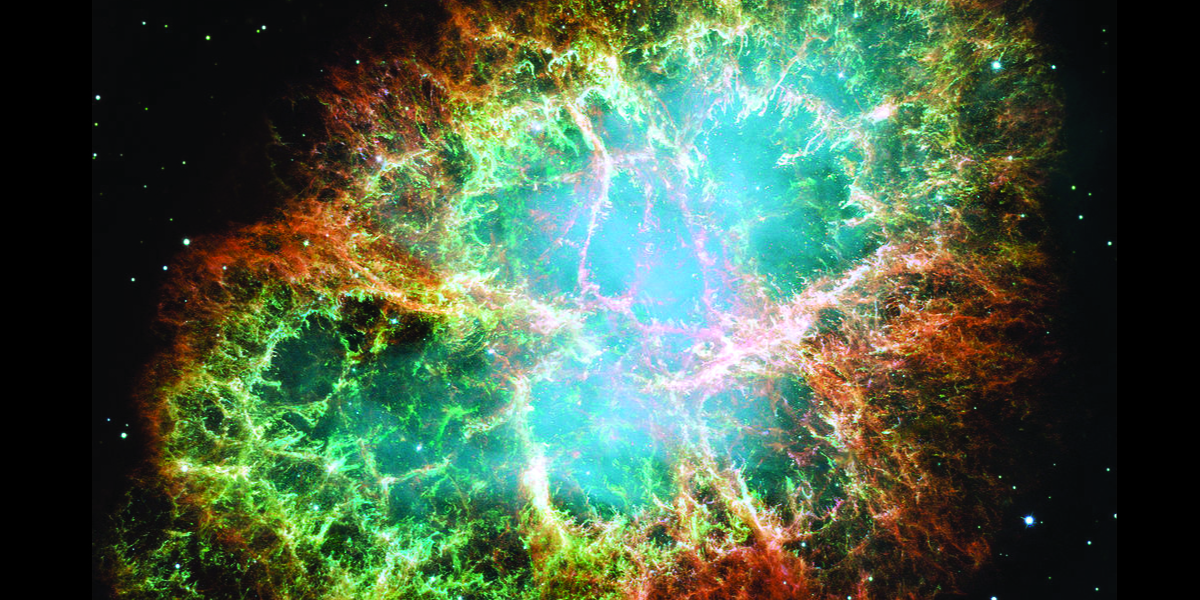Module 7. Light, Matter, and Atomic Structure
Background
In 1054, Chinese astronomers recorded the appearance of a “guest star” in the sky, visible even during the day, which then disappeared slowly over the next two years. The sudden appearance was due to a supernova explosion, which was much brighter than the original star. Even though this supernova was observed almost a millennium ago, the remaining Crab Nebula (Figure 1) continues to release energy today. It emits not only visible light but also infrared light, X-rays, and other forms of electromagnetic radiation. The nebula emits both continuous spectra (the blue-white glow) and atomic emission spectra (the colored filaments). In this chapter, we will discuss light and other forms of electromagnetic radiation and how they are related to the electronic structure of atoms. We will also see how this radiation can be used to identify elements, even from thousands of light years away.
In this module, you will learn how important discoveries made in the early 20th century fundamentally changed our understanding of electrons and their behavior. Through the application of quantum mechanical principles, we can predict electronic structure and make sense of periodic trends and chemical reactivity. In this module, you will learn about the particle properties of waves and the wave properties of matter. You will learn how and why the energies of electrons in atoms exist at discrete (quantized) values. You will also learn about how wave functions and quantum numbers describe electron orbitals for single-electron hydrogen atoms and multi-electron elements. You will predict electron configurations of atoms and ions. You will also use the principal quantum number and effective nuclear charge to explain experimentally observed periodic trends.

Learning Objectives for Light, Matter, and Atomic Structure
- Describe the basic properties of light as a wave.
- Identify the evidence for the particle nature of light as revealed by the photoelectric effect.
- (a) Summarize the connection between discrete line spectra and how energy levels of atoms are quantized. (b) Predict the observed emission and absorption frequencies and wavelengths of photons using the Bohr theory.
- (a) Illustrate how the diffraction of electrons reveals the wave properties of matter. (b) Apply DeBroglie’s equation to relate mass, velocity and wavelength. (c) Recognize that quantum theory leads to discrete energy levels and associated wave functions; explain the probabilistic interpretation of wave functions.
- Describe the energy levels and wave functions for the hydrogen atom using three quantum numbers.
- Rank orbital energies and determine electron configurations.
- Apply the Aufbau principle to rationalize the structure of the periodic table.
- Correlate the effective nuclear charge with selected trends in periodic properties.
Why is this content important?
Quantum mechanics – the mathematical description of subatomic particles and light – can be perceived as being rather abstract and only of theoretical interest to scientists, but nothing could be further from the truth. The discoveries resulting from our understanding of the quantum mechanical world have lead to revolutions in computing, telecommunications, and medical imaging, things that we now take for granted as the following article highlights, What has Quantum Mechanics Ever Done For Us?
The idea of being able to transport matter instantaneously from one location to another (teleportation) is definitely popular in the world of science fiction, and of course in Harry Potter where “portkeys” are a rather convenient method of transportation. While widely regarded as a fictional idea, there are scientists working to make teleportation a reality. By applying quantum mechanical concepts, physicists have recently teleported a particle of light a distance of six kilometers. While teleporting photons is vastly different than teleporting an entire human, this is a significant breakthrough – bringing an idea from the realm of science fiction closer to reality. As this article explains, the ability to teleport photons has enormous potential to transform computing and communications.
Please use this form to report any inconsistencies, errors, or other things you would like to change about this page. We appreciate your comments. 🙂

